Communications
Written communications
This page provides information on Feed the Future Innovation Lab for Horticulture written and visual communications; required branding, including information about logos, a required disclaimer, required phrasing, and other style guidelines. It is intended for use by Principal Investigators (PIs) and other partners who are currently funded as part of the Feed the Future Innovation Lab for Horticulture network.
General
Feed the Future Innovation Lab for Horticulture communications provides all aspects of support, from announcing and sharing new projects and research results to producing high-quality publications and other communications-related materials, as well as developing and coordinating events to connect researchers to development stakeholders.
Sharing research results
To share the outcomes of Innovation Lab for Horticulture-funded research and to request any assistance with sharing results at any point in the project timeline, contact Archie Jarman and (rajarman@ucdavis.edu) and Heather Hayashi (hnhayashi@ucdavis.edu). For all events-related queries: Archie Jarman (rajarman@ucdavis.edu).
Funding acknowledgements
For more on funding acknowledgement, refer to the section on Disclaimer Language (pages 42-3) in the Feed the Future Graphics and Naming Standards Manual.
Research papers
As a public academic research and education program, we are required to make available all products that come from funded Horticulture Innovation Lab projects, including working papers, results summaries and journal publications. Research papers should acknowledge Feed the Future Innovation Lab for Horticulture funding with the following text:
“This research was funded by the Feed the Future Innovation Lab for Horticulture and made possible by the generous support of the American people through the United States Agency for International Development (USAID). The contents of this publication are the responsibility of the authors and do not necessarily reflect the views of USAID or the United States Government.”
Other materials
For communications materials such as video, powerpoint presentations, webinars, trainings, etc. the following should be included:
“This [specify: video, webinar, event, etc.] is made possible by the generous support of the American people through the United States Agency for International Development (USAID). The contents are the responsibility of the Feed the Future Innovation Lab for Horticulture [insert project name] and do not necessarily reflect the views of USAID or the United States Government."
USAID branding Press releases and written pieces
When writing about your Horticulture Innovation Lab project in public communications — press releases in particular or other text-only articles such as a journal article or blog post — you are required to include a phrase in the text substantially similar to:
"… supported by the Feed the Future Innovation Lab for Horticulture with funding from the U.S. Agency for International Development, as part of the U.S. Government’s global hunger and food security initiative."
Branding
USAID, Feed the Future, UC Davis and Horticulture Innovation Lab
Due to the collaborative nature of the Feed the Future Innovation Lab, there are several guidelines we must follow, in order to ensure an inclusive and respectful incorporation of the identities and marks that represent our global network. It is helpful to understand the roles between the partners in order to remember the way to display their relationships through their logos and markings as designated by each.
USAID is the funder of the Feed the Future Initiative, while UC Davis is the host-institution for the Feed the Future Innovation Lab for Horticulture leadership team in the United States.
USAID branding
The USAID Branding Policy is mandated by Congress. Feed the Future Innovation Lab for Horticulture is considered a USAID-funded Assistance Program, and thus is allowed to co-brand, featuring partner logos - following USAID guidelines. Branding resources, including downloadable USAID logos, may be found at usaid.gov/branding/resources, and an educational video is available here. General guidelines for logo-use include:
- USAID logo must always be displayed as the logo at bottom left
- No other logo must be larger than it (with the exception of the Feed the Future logo)
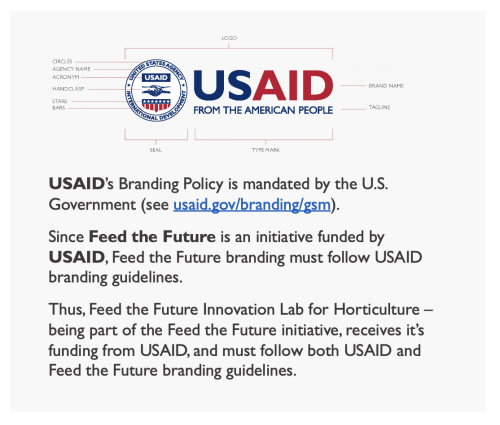
Feed the Future branding
Feed the Future is a global food security initiative funded by USAID. Branding guidelines and downloadable logos for Feed the Future may be found at feedthefuture.gov/branding. General guidelines for logo-use include:
- Feed the Future logo must always be displayed as the logo at the very top left of a program material
- No logo may appear larger than the Feed the Future logo
UC Davis branding
As the host-institution for the USAID-funded Feed the Future Innovation Lab for Horticulture, UC Davis has it's own set of logos and branding, which are all applied towards administrative items - materials where USAID and Feed the Future have instructed that their logos are not permitted to be displayed (p. 38). Administrative materials include e-signatures, business cards and letterheads. General guidelines for logo-use:
- when used in administrative items (where USAID and Feed the Future logos are not permitted to be displayed), use the extended version of the mark (with University of California, Davis) whenever possible, for global recognition
Horticulture Innovation Lab branding
For more examples, see page on BRAND REPUTATION.
For for resources, including downloadable logos, templates, cheatsheets etc., see very bottom of this page.
Naming
Feed the Future Innovation Lab for Horticulture will be referred to formally as such, or, informally as: Horticulture Innovation Lab - once it has been introduced in the following manner.
For example -
"The Feed the Future Innovation Lab for Horticulture, also referred to as the Horticulture Innovation Lab, is managed by a team..."
Acronyms such as HIL or ILH are highly discouraged by USAID.
Colors
Use Feed the Future colors (see p. 19)

Fonts
Use Feed the Future fonts (see p. 20-3)
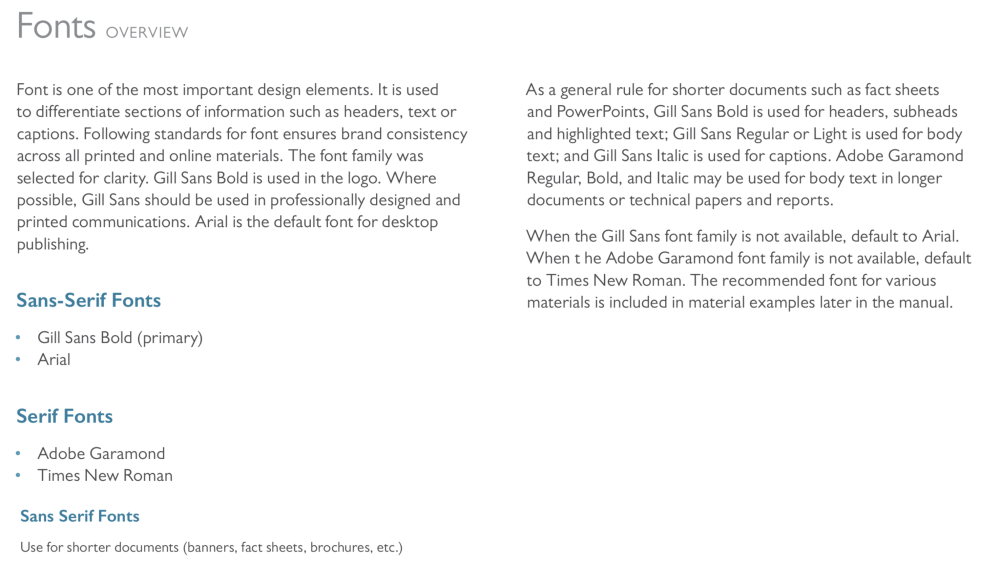
Proper Logo Treatment: Spacing Requirements
A minimum area or “clear space” surrounding the Feed the Future logo must be kept free of any other text or graphic elements, such as illustrations, thematic images, and the trim edge of a printed piece. In certain cases, the logo may be overlayed on top of a photograph or patterned background provided that the logo is still clear and legible. The photograph or pattern must not be overly distracting from the logo. Minimum clear space on all sides is equal to the height of the Feed the Future text, no matter the size of the tagline. The letter “D” from the word “FEED” determines the height and width of the clear space around the logo, as shown below. Products should use more than the minimum clear space where possible (see below for reference from p. 16).
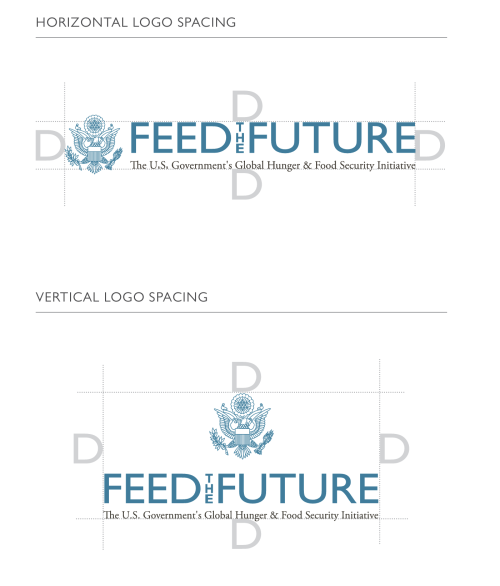
EXAMPLES BELOW of properly branded presentation slides, and the breakdown of what is being shown:
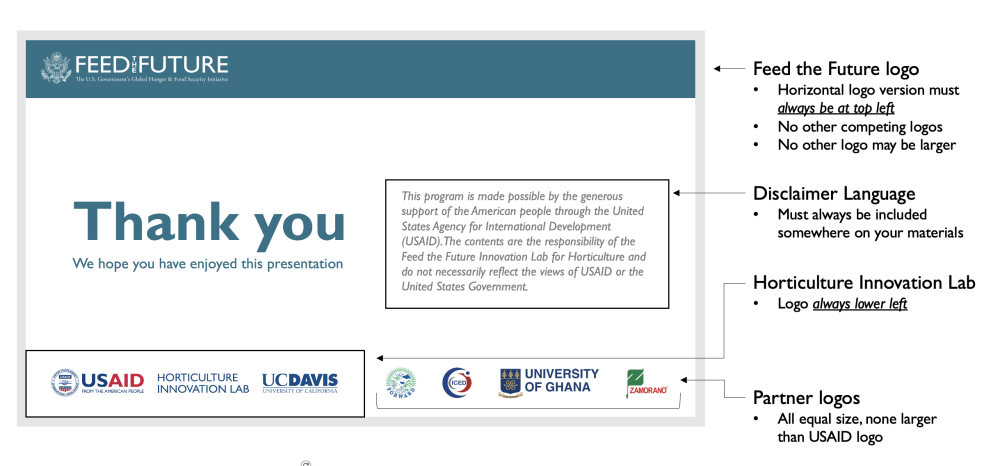
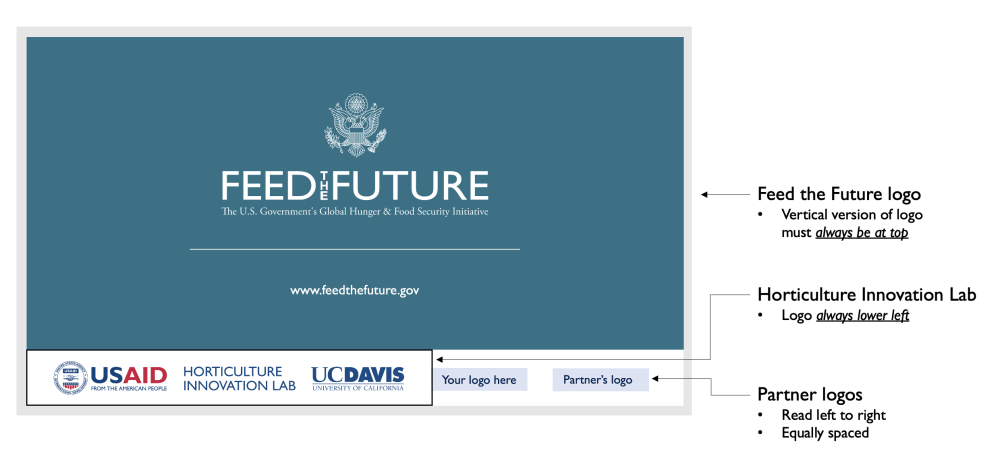
Editorial Style Guidelines
Digital story submissions
To meet USAID Agrilinks digital publication submission standards, a good reference to follow is their Editorial Style Guide. Tips here include how to title a story, as well as photo requirements (dimensions, resolution, naming, describing, photo crediting).
Visual Storytelling
Photos, visual communication and multimedia
Below are resources on storytelling through the use of photos, videos, and other activities.
Photos
Guidance on capturing photos
- Guidance on taking photos of your project
- Photo Guide for USAID Partners webpage and PDF
- Feed the Future Press Kit, including Digital and Brand assets, Photography and Social Media
- For what Feed the Future looks for in terms of composition, storytelling, captioning and photo-crediting, browse the Feed the Future Flickr collection
Sending photos for media use and public access archiving on Flickr
When sending photos to be shared for external communications – and publicly archived to our Horticulture Innovation Lab Flickr account – please provide as much information as possible, including descriptive title and photo credit. For tips on this:
- The Agrilinks Editorial Style Guide has a good Photos section to reference, especially when preparing to submit a digital story to their newsletter. These include requirements for photo: credits, descriptions, image quality, file names, and alt tags.
- Alternatively, a quick and easy way might be to simply:
Name the photo title with the description (who, what, when, where, image credit)
For more, including examples, view this document.
Visual communication
- Telling your research project's story
- Using the power of video to amplify your work
- Here is a 5-minute presentation on branding
Multimedia
Here is a general UC Davis social media training presentation on how to manage your professional profile:
- 2021 TRAINING: Earned & Social Media
Communicating and Amplifying Your Research to the Public and Media
Websites and webpages
Any project website or webpage must be approved first by Feed the Future, before going live. Please contact your Regional Hub Manager(s) for assistance on how to start the process. For Feed the Future brand requirements on websites and webpages, refer to pages 37-8.
Additional Brand Resources
Downloadable logos and templates
Feed the Future Branding Guidance Training
View modules 1-39, and 43-46: feedthefuture.gov/resource/feed-the-future-branding-training-module/
Templates for download
- 2024 Presentation Template.pptx (basic) // 2024 Brand Training Template (option )
- 2024 Banner (24x56).pptx
- 2024 Factsheet.pptx // 2024 Factsheet (option).pptx (refer to pages 28-9)
- 2024 Project Sign (36x56).pptx (refer to page 32)
- 2024 Video frames.pptx (refer to page 47)
- 2024 Annual Meeting Poster templates:
- 48x36" Landscape version
- QR code landscape version
- 36x48" Portrait version
- QR code portrait version
- 48x36" Landscape version
Administrative Item Templates
For administrative items such as e-signatures, business cards and letterheads, USAID and Feed the Future logos are not permitted to be displayed (p. 38). Thus, we must then follow UC Davis branding. Below are templates provided for the following administrative items:
